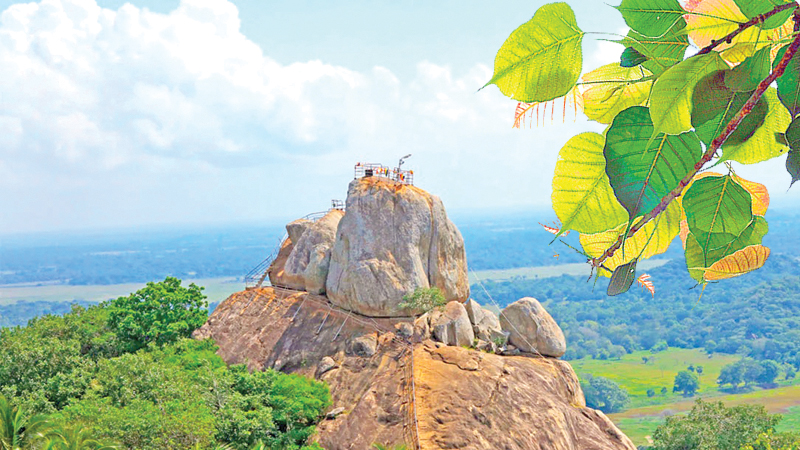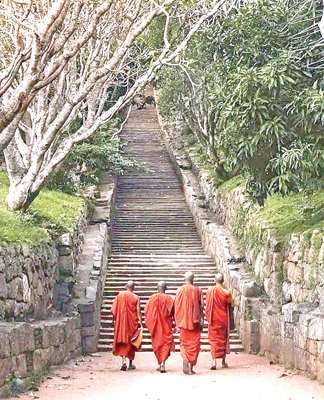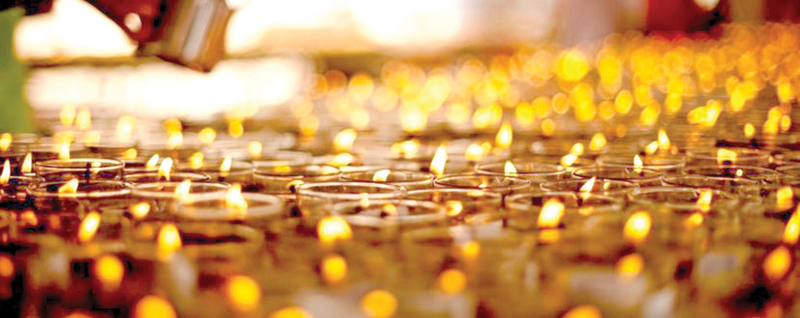Poson: Watershed moment in Sri Lanka’s history – By Pramod de Silva
 It is a story that is well known, but worth repeating. Legend has it that one fine Full Moon Poya Day nearly 2,330 years ago, King Tissa was hunting deer in a park close to the Royal City of Anuradhapura. Then he heard someone calling his name.
It is a story that is well known, but worth repeating. Legend has it that one fine Full Moon Poya Day nearly 2,330 years ago, King Tissa was hunting deer in a park close to the Royal City of Anuradhapura. Then he heard someone calling his name.
Since no one in the country dared to call the King by his name, he turned upward to see just who could denigrate the King in this manner. It was a sight that immediately calmed him down – a retinue of saffron-robed monks and a sage.
Great message
The visitor on top of the rock, now called Mihintale, was none other than Arahat Mahinda Thera, son of the great Emperor Dharmashoka in neighbouring Jambudvipa, present day India. “Oh great King, we are monks, disciples of the King of Truth. We have come from Jambudvipa (India) in our compassion for you,” Arahat Mahinda Thera told the King.
He had brought the precious gift of the Buddha Dhamma to Sri Lanka. In honour of this great deed, Arahat Mahinda is also referred to as “Anubudu”, which means he is second in importance only to the Buddha for Sri Lankan Buddhists.
He asked a series of questions from the King to gauge his intelligence and all the answers were correct. It did not take too long from that moment for the King and his 40,000 followers to embrace the timeless words of the Enlightened One after Arahat Mahinda Thera delivered the discourse of Chulla Haththi Padopama Sutta (Simile on the Foot of an Elephant). It is a Sutta in the Majjhima Nikaya (Middle-length Discourses of the Buddha of the Sutta Pitaka) that clearly explains the path to Nibbana or the End of all Suffering, the ultimate goal of every Buddhist.
Arahat Mahinda was also responsible for the inception of the Sangha Order in Sri Lanka. It is believed that at one time more than 5,000 Arahats and other bhikkhus lived in Anuradhapura alone. It is now a UNESCO World Heritage Site with a number of sacred Buddhist monuments including the Ruwanweli Maha Seya and the Sacred Jaya Sri Maha Bodhi, perhaps the oldest historically documented living tree in the world. Incidentally, the sacred Sri Maha Bodhi was brought here as a sapling by Sanghamitta Therani, the daughter of King Dharmashoka. Both Arahat Mahinda and Sanghamitta Therani lived the rest of their lives in Sri Lanka, spreading the sublime words of the Buddha, while their father’s emissaries went to all parts of Asia with the message of the Buddha.
Origin of Buddhism-based civilisation
King Tissa earned the sobriquet “Devanampiya” (Beloved of the Gods) after he embraced Buddhism. This was the moment that started a Buddhism-based civilisation and an agri-based socio-cultural revolution in Sri Lanka that continues to this day. This gave rise to the concept of “tank, temple and village”, which denotes the nexus between our agri-based civilisation and Buddhism. Thus Poson can be called a watershed moment in Sri Lanka’s rich annals. To Sri Lankan Buddhists, it is second in importance only to Vesak, which marks the Buddha’s Birth, Enlightenment and Passing Away. Just last month, Buddhists all over the world celebrated Vesak.
While Sri Lanka has embraced a multi-ethnic, multi-cultural milieu, the tenets and ethos of Buddhism have permeated to every level of our society, regardless of ethnicity and religion.
Indeed, both Vesak and Poson are marked in various ways by non-Buddhists as well. Poson celebrations centre on Mihintale, where thousands of devotees converge to recall with gratitude Ven. Arahat Mahinda Thera’s journey to Sri Lanka.
It is this unique adherence to the Four Sublime States mentioned in Buddhism – Metta (Loving Kindness), Karuna (Compassion), Muditha (Sympathetic Joy) and Upekkha (Equanimity) that has enabled Sri Lankans to wither any obstacle in life, be it the 30-year-War, the Boxing Day Tsunami, the Coronavirus pandemic and the economic downturn.
The Buddha Dhamma gave prominence to two factors essential for life – health and the environment. The Buddha noted that health was the greatest wealth.
This was not surprising, since the Buddha had realised the essential link between the two, having attained Enlightenment under the shade of a mighty Bo Tree.
Our affinity for Nature and the Environment goes back all the way to that initial interaction between Arahat Mahinda Thera and King Devanampiyatissa at Mihintale. Arahat Mahinda stopped the King’s hunt, extolling that all life is precious and that we should radiate compassion towards all beings.
Intelligence test
He tested the King’s intelligence with questions about the mango grove in Mihintale, which the latter successfully answered. From then on, our Kings declared Abhaya Bhoomi or sanctuaries where life was allowed to blossom freely. Mihintale is a sanctuary to this day.
The United Nations (UN) has warned that human actions, including deforestation, encroachment on wildlife habitats, intensified agriculture, and acceleration of Climate Change, have pushed Nature beyond its limit. It would take 1.6 Earths to meet the demands that humans make of Nature each year. If we continue on this path, biodiversity loss will have severe implications for humanity, including the collapse of food and health systems.
Covid-19 underscored the fact that, when we destroy biodiversity and interfere with Nature, we destroy the very systems that support human life. Today, Nature is under severe strain due to a variety of factors from plastics pollution to fossil fuel use. Many of the animals and plants that we now take for granted could be gone from our midst in just 50 years. If we continue burning fossil fuels, our coastal cities could be inundated by 2100 as a result of Climate Change and an associated sea level rise. It is time for the world to work together to honour the commitments to the environment and save the only planet we have.
Thus Poson should be an occasion to align our lives with the sublime teachings of the Buddha and the paramount need to save our Planet and all life on Earth. Poson, which marks the arrival of the Greatest Gift of Buddhism in Sri Lanka, is an occasion to get closer to the Dhamma as it relates to our everyday lives.









